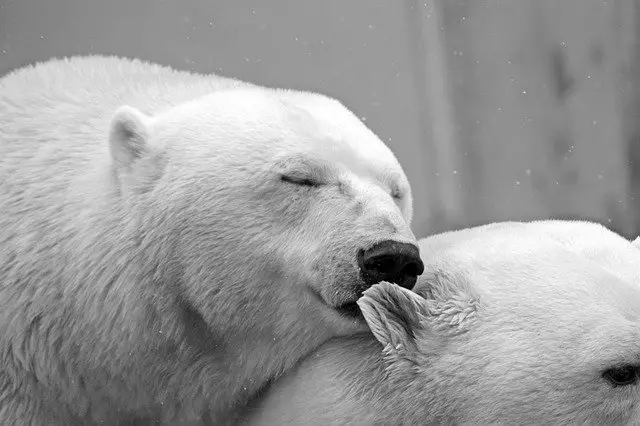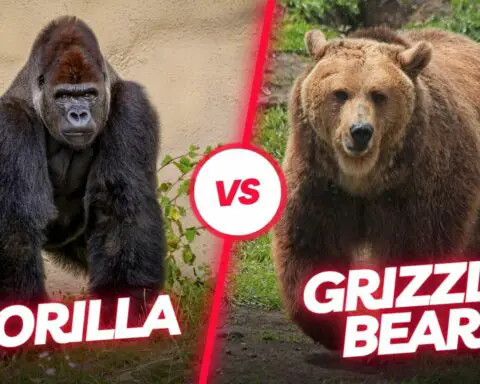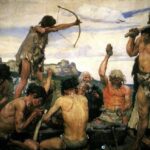Grizzly Bears are well known for their strong body and huge size. They are the largest omnivores in North America. We have gathered a complete set of Grizzly Bear Facts For Kids that will help you in learning all about Grizzly Bears. You are going to learn about its name, scientific classification, physical features such as size, weight and height, evolution, face, paws, habitat, diet, hunting, lifespan, reproduction, endangerment, population, types, predators, hibernation, babies, importance, protection and many other interesting facts about the Grizzly Bear.
Grizzly Bear Facts For Kids
Overview
- The grizzly bear is the brown bear that is found in North America.
- Grizzly bears have a huge size with an average body size of 6.5 feet, and an average body weight of 180 to 360 kg (400 to 790 lbs).
- Their current habitat range covers Alaska, parts of the northwestern United States, and much of western Canada.
- The digestive system of grizzly bears is similar to meat-eating animals (carnivores). However, they are omnivores and eat diets of both animal and plant origin. When you compare brown bear vs grizzly bear, they both have similar diets. Plus, these omnivores eat a variety of foods, depending on the availability. This includes fish, nuts, berries, honey and other plants.
- Grizzly bears hibernate during the winter season. They prepare a den for their hibernation. Throughout this period, they do not eat, urinate, or defecate. While the females also give birth to offspring during this period.
- Grizzly bears are territorial and need extremely large space to flourish. The territories of male grizzly bears are up to 4,000 km² (1,500 square miles).

What Is A Grizzly Bear
- The grizzly bear is a subspecies or population of the brown bear found in North America.
- It is also known as just a grizzly or North American brown bear.
- It is a large size animal with humped shoulders and a big head.
- Sometimes, other morphological forms or varieties of brown bears in North America are also classified as grizzly bears, such as the Peninsular grizzly (Ursus arctos gyas), the Kodiak bear (Ursus arctos middendorffi), as well as some extinct populations.
- In the Continental United States, it is protected by law. However, it is not protected in Alaska.
- The current population of grizzly bears is around 55,000 individuals. So the IUCN Red List classified the animal as Least Concern.
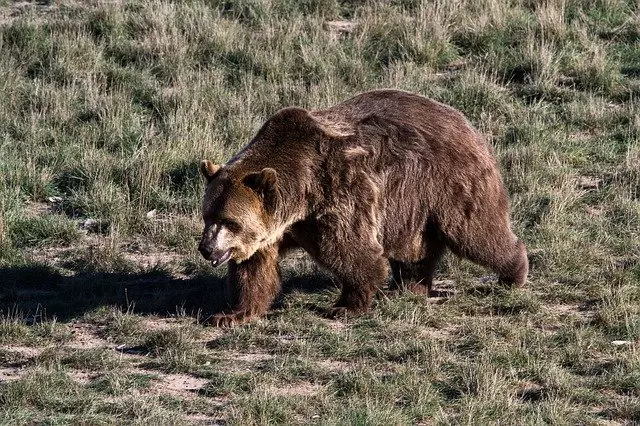
Why Are Grizzly Bears Called Grizzly – What Does Grizzly Bear Mean
- The American explorers Meriwether Lewis and William Clark first described the animal as Grisly, which means horrible or fear-inspiring.
- Some sources say that grizzly bears are called Grizzly because their hair is grizzled (grey-tipped or silver-tipped).
- However, zoologist George Ord classified the animal in 1815 as U. horribilis. It shows that the modern spelling supposes the meaning based on the animal character, not its hair.
Grizzly Bear Scientific Name
- The scientific name of the grizzly bear is Ursus arctos horribilis.
Grizzly Bear Scientific Classification
- The following is the scientific classification or taxonomy of grizzly bear:
| Kingdom | Animalia |
| Phylum | Chordata |
| Sub-phylum | Vertebrata |
| Class | Mammalia |
| Order | Carnivora |
| Family | Ursidae |
| Genus | Ursus |
| Species | Ursus arctos |
| Subspecies | Ursus arctos horribilis |
Grizzly Bear Evolution
- The ancestor of brown bears is Etruscan bears that lived in Eurasia and North Africa from about 5.3 million years to 100,000 years ago.
- The origin place of brown bears in Eurasia, where they originated around 1.3 million years ago.
- Around 50,000 years ago, they crossed the Bering Strait Bridged and traveled to North America.
- It is believed that approximately 13,000 years ago, brown bears spread into the contiguous United States.
What Does A Grizzly Bear Look Like – Grizzly Bear Appearance
- Grizzly bears are huge-sized animals with muscular humps at the shoulders.
- They have an elevated forehead, which gives them somewhat a concave profile.
- Their rump is lower than their shoulders.
- They have thick fur, the color of which changes from blond to blackish.
- The most common hair color of the grizzly bears is brownish to buff with darker legs and commonly silver or blond tipped fur on the back and body sides.
Grizzly Bear Profile
- The profile of the grizzly bear is concave with short, rounded ears and an elevated forehead.
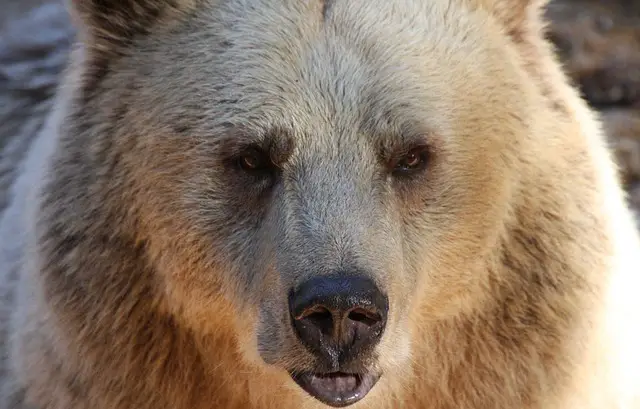
How Much Does A Grizzly Bear Weigh – How Heavy Is A Grizzly Bear
- The average weight of adult male grizzly bears is from 180 to 360 kg (400 to 790 lbs).
- While the average weight of adult female grizzly bears is from 130 to 180 kg (290 to 400 lbs).
Heaviest Grizzly Bear
- The recorded heaviest grizzly bear was a male whose weight was reported up to 680 kg (1,500 lbs).
How Big Is A Grizzly – How Big Do Grizzly Bears Get – How Big Can A Grizzly Bear Get
- The average total length of the grizzly bears is up to 6.50 feet (1.98 m).
- Their size ranges from 3.3 to 9.0 feet (1 to 2.8 meters).
- In size and weight, the grizzly bears found near the coastal regions tend to be larger than those found in the inland regions.
Biggest Grizzly Bear – Largest Grizzly Bear
- Bears are scored based on their skull measurement (length and width).
- The record of the world’s largest grizzly bear is given to a skull found in Alaska in 1976.
- The Big Bruin was a grizzly bear hunting in 2013 by Larry Fitzgerald in Alaska. It scored the record of the world’s second-largest grizzly bear ever recorded.
- Goliath was an Alaskan grizzly bear that lived between 1967 and 1991 at Space Farms. His weight was described as a short ton (907 kg), while his body length was measured as 12 feet. He is often described as the biggest grizzly bear ever in captivity.

How Tall Can A Grizzly Bear Get – Tallest Grizzly Bear
- The average height of grizzly bears at the shoulder region is 3.3 feet (1 meter).
- Big coastal male grizzly bears stand up to 4.9 feet (1.5 meters) tall at the shoulder region.
How Tall Does A Grizzly Bear Stand – Grizzly Bear On Hind Legs
- Big coastal male grizzly bears stand up to 9.8 feet (3 meters) tall at their hind legs.
How Long Do Grizzly Bears Live – Grizzly Bears Lifespan
- The estimated average lifespan of male grizzly bears is 22 years, while that of females is 26 years.
How Long Do Bears Live In The Wild
- The lifespan of female grizzly bears is longer than males.
- Male grizzly bears engage in seasonal breeding fights, which make their lives more dangerous and that is why they have a reduced lifespan than females.
- Males live for an average life of 22 years, while females for 26 years in the wild.
- The oldest wild grizzly bear lived for about 34 years in Alaska.
How Long Do Bears Live In Captivity
- The lifespan of grizzly bears in the wild is as long as 44 years.
Grizzly Bear Paw
- Grizzly bears have four paws.
- Their paws have tough pads that act like snowshoes.
- Every paw has five toes, and each toe ends on a long claw.
How Many Claws Does A Grizzly Bear Have
- Each paw of the grizzly bear has five claws.
- So collectively, a grizzly bear has 20 claws.
How Big Are Grizzly Bear Claws
- The front claws of grizzly bears are 2 to 4 inches in size.
- The hind claws may be slightly shorter than the front claws.
Grizzly Bear Head
- A grizzly bear has a massive head.
- Their head has two small rounded ears at the top and a dished face.
How Many Teeth Does A Grizzly Bear Have
- Grizzly bears have 42 teeth located at their upper and lower jaws.
Where Do Grizzly Bears Live – Grizzly Bears Habitat
- Grizzly bears live in diverse habitats including temperate coastal rainforests, alpine tundra, dry grasslands, boreal forests, and Arctic tundra.
- They prefer to live in regions close to water streams and rivers.
- Grizzly bears need a lot of space to live in. Their home range covers up to 600 miles.
- Their favorite habitats are the isolated regions from human development with abundant food and places to dig their burrows or dens.
Where Are Grizzly Bears Found – Where Are Grizzly Bears Located – Grizzly Bears Habitat Range
- Grizzly bears are found in North America.
- Their previous habitat range was from Alaska to Mexico and as far as the western regions of Hudson Bay.
- Their current habitat range covers Alaska, much of western Canada, parts of the northwestern United States (Washington, Idaho, Montana, and Wyoming), and extending at the south as far as Yellowstone and Grand Teton National Parks.
- In Canada, they are found in British Columbia, Alberta, the Yukon, the Northwest Territories, Nunavut, and the northern regions of Manitoba.
Where Do Grizzly Bears Live Map
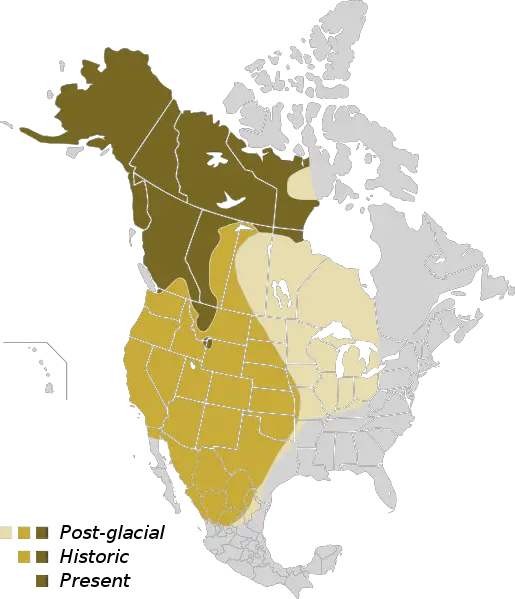
Glacier National Park Grizzly
- Glacier National Park is a wilderness area in the rocky mountains of Montana State of the United States.
- About 800 grizzly bears are found in Montana, in which around 300 or more grizzlies are found in the Glacier National Park.
- Some sources say that since 1967, grizzly bears have killed eight people in Glacier National Park.
Grizzly Bear Yosemite
- Yosemite National Park is located in the Sierra Nevada of California, USA.
- Currently, there are no grizzly bears in the Yosemite National Park.
What Do Grizzly Bears Eat – Grizzly Bear Diet
- A grizzly bear belongs to the order Carnivora and has the digestive system of meat-eating animals or carnivores.
- However, the grizzly bear is normally an omnivore; and consumes a diet of both animal and plant origin.
- Grizzly bears are known to hunt large mammals when available, such as moose, bison, bighorn sheep, elk, mule deer, white-tailed deer, caribou, and black bears.
- However, they usually avoid healthy adults and mostly take injured adults and calves.
- They also eat fish, such as salmon, bason, and trout.
- Grizzly bears are also scavengers and eat the leftovers of other animals.
- They also eat birds and their eggs and sometimes attack the nests of raptors like bald eagles.
- The diet of grizzly bears differs according to their habitat.
- In coastal regions, such as in British Columbia and Alaska, they supplement their diet with protein and fat-rich salmon and clams. While in plant matter, they eat berries and sedge grasses. Due to an energy-rich diet, Alaskan or Canadian grizzly bears tend to grow bigger than those found in mountainous and other non-coastal regions.
- In Yellowstone National Park, grizzly bears mostly eat various types of rodents, army cutworm moths, grasses, tubers, whitebark pine nuts, and scavenge on carcasses.

How Much Do Grizzly Bears Eat
- Grizzly bears may eat about 90 lbs (40 kg) food per day.
- While they gain a bodyweight of about 2.2 lbs (1 kg) or more per day.
Do Grizzly Bears Hunt – How Do Grizzly Bears Hunt
- Yes, grizzly bears hunt a lot of animal species.
- To hunt a moose or bison, a grizzly bear stalks them using a cover or hunts a weak or young individual.
- They dig the grounds and overturn rocks to find rodents.
- They also dig the sand along the coasts to find razor clams.
- To catch fish, especially salmon, they wait at the base of waterfalls to catch leaping salmon.
- Grizzly bears are experts in chasing fish and pinning them in their claws.
What Do Grizzly Bears Hunt
- Grizzly bears usually hunt the injured or young individuals of large size animal species, such as hoofed mammals (moose, bison, bighorn sheep, elk, and deers).
- They also hunt rodents, birds, and their eggs.
- They are well-expert in catching fish, such as salmon, trout, and bass.
Grizzly Bear Catching Salmon
- Grizzly bears gather in regions where salmons are forced to jump waterfalls.
- They wait at the base of the waterfall to capture and feed on the leaping salmon.
- Salmon are at risk when they leap waterfalls because they cluster together at the base of the waterfall and become an easy target for the grizzly bears.
Grizzly Bears Hibernation
When Do Grizzly Bears Hibernate
- Grizzly bears hibernate at the start of winter.
- Their hibernation period usually starts in late November, however, it may depend on the temperature, food supply, and snowfall.
- In California, where the climate is warm, grizzly bears do not hibernate.
Where Do Grizzly Bears Hibernate – Where Do Grizzly Bears Sleep
- Grizzly bears prepare a den where they hibernate.
- Their dens are typically located on the north-facing slopes at altitudes of about 1,800 meters (5,900 feet).
How Do Grizzly Bears Hibernate
- Grizzly bears hibernate during the winter season.
- To prepare themselves for hibernation, grizzly bears consume a huge amount of food.
- They undergo a period of hyperphagia or polyphagia (extreme sensation of hunger or strong desire for eating). During this period they can gain a bodyweight of approximately 180 kg (400 lbs).
- Before entering their den, grizzly bears wait for a considerable snowstorm.
- During hibernation, they do not sleep the whole time.
- Throughout the entire period of hibernation, grizzly bears do not eat, urinate, or defecate. During this period, partial recycling of body wastes occurs in their body.
- Deep sleep and inactivity allow them to conserve energy.
- During hibernation, the rate of their heartbeat slows down from 40 beats per minute to only 8 beats per minute.
- During hibernation, pregnant female grizzly bears give birth to offspring. Mothers nurse their offspring who gain strength in the remaining period of hibernation.
When Do Grizzly Bears Wake Up From Hibernation
- Male grizzly bears wake up from hibernation in the early to mid-March.
- While females wake up in April or early May.
What Is A Male Grizzly Bear Called
- A male grizzly bear is called a boar.
What Is A Female Grizzly Bear Called
- A female grizzly bear is called a sow.
Grizzly Bear Reproduction – When Do Grizzly Bears Give Birth – Grizzly Bear And Cubs
- Among all the North American terrestrial mammals, grizzly bears are one of the animals with the lowest reproductive rate.
- This is because of many ecological factors, such as:
-
- They reach sexual maturity at the age of 5 years.
- Females delay the implantation of embryos until hibernation. If she does not receive proper nutrition during this time, a miscarriage can occur.
- The mother does not mate until her cubs become independent. The cubs are independent at the age of 2 years.
- After the cubs are independent or killed, the females may also not breed for 3 or more years depending on environmental conditions.
- The territories of male grizzly bears are up to 4,000 km² (1,500 square miles). It makes it difficult for them to find the scent of females in such large regions and such low population densities.
- If a female mates in summer, she will delay the implantation of embryos until hibernation.
- After a gestation period of 180 to 250 days, the cubs are born during hibernation in the winter den.
- Mothers are aggressively protective of their cubs and defend their cubs in any way.

How Many Cubs Do Grizzly Bears Have
- Female grizzly bears have 1 to 4 cubs.
- The average number of cubs in a litter is 2 or 3.
- They usually have 2 cubs.
How Long Do Grizzly Bear Cubs Stay With Their Mother
- Grizzly bear cubs stay with their mother for up to 2 years.
Baby Grizzly Bear – Newborn Grizzly Bear
- Baby grizzly bears are known as cubs.
- At birth, they weigh about 450 g (1 lb).
- They are always born during the hibernation of their mother.
- During the hibernation of their mother, the cubs feed only the milk of their mother.
- When the summer comes and the hibernation of their mothers passes, they also start eating solid food along with milk.
- The cubs gain so much weight during the time they spend with their mothers. During two years, their body weight will increase from 4.5 to 45 kg (10 to 99 lbs).
- The cubs are weaned at the age of 2 years and they become independent.
- They become sexually mature at the age of 5 years.
- The mortality rate of the cubs is high and most of them are killed by predators or hunters in the first few years of their life.
Types Of Grizzly Bears
Mexican Grizzly Bear
- The Mexican grizzly bear is an extinct population of the grizzly bears found in the northern territories of Mexico.
- Its scientific name was Ursus arctos nelsoni.
- It was smaller in size than the brown bears of the northern United States and Canada.
- Mexican grizzly bear was one of the largest and heaviest mammals in Mexico.
- They became extinct due to the expansion of cattle farming in their habitat range. The farmers killed them as they were pests for their farms.
- They were considered as being extinct by 1964.
Kodiak Grizzly Bear
- The Kodiak bear (Ursus arctos middendorffi) is a population or subspecies of the brown bear found in the islands of the Kodiak archipelago in Alaska.
- It is one of the two largest living bears (the other is the polar bear) and the largest subspecies of the brown bear.
- Despite the difference in size, the Kodiak bear is very similar to the mainland grizzly bear, and the now-extinct California grizzly bear.
- It is also similar to other populations or subspecies of brown bears in diet, behavior, and other aspects of life.
Black Grizzly Bear
- In 1986, a bear of black color was shot in Michigan that had an unusually larger size and a large skull and braincase than those of the black bears.
- It was believed to be a hybrid of black and grizzly bears.
- However, the DNA test of the animal was unable to determine whether it was a grizzly bear or the American black bear of exceptional size.
Albino Grizzly Bear – White Grizzly Bear
- A white grizzly bear was seen by a family driving on a remote highway in the Rocky Mountains of Canada.
- The family made a video of the white grizzly through a mobile phone that became viral.
- Since 2017, the local wildlife officials have known about the white grizzly bear in that region.
- Experts say that the white color of the grizzly was not because of albinism, but it was due to a recessive gene.
Silvertip Grizzly Bear
- Grizzly bears are also sometimes known as silvertip grizzly bears because the tips of their fur have a silver color.
Mangelsen Grizzly
- Thomas D. Mangelsen is a legendary wildlife photographer who made some of the most famous images of the grizzly bears in Wyoming.
- He also featured 150 spectacular images of a female grizzly, known as Grizzly 399 in the book Grizzlies of Pilgrim Creek.
Why Are Grizzly Bears Endangered
- Grizzly bears are not endangered now.
- Their conservation status on the IUCN Red List is Least Concern.
- However, there are many threats to their survival, such as; loss of habitat due to mining, logging, drilling for oil and gas, and land development. Climate change due to global warming is also a threat that influences their survival.
Why Are Grizzly Bears Hunted
- In the past, grizzly bears were hunted for their fur and meat.
- In modern times, they have been hunted as big-game hunting because of their large size and savagery.
Why Are Grizzly Bears Important – Why Is A Grizzly Bear A Keystone Species – How Do Grizzly Bears Help The Environment
- Grizzly bears are very important and help the environment in many ways. That is why many people consider grizzly bears as a keystone species. The following are some of the important roles that grizzly bears play to keep the environment healthy:
- There are several relationships between the grizzly bears and the ecosystem. They are important seed distributors as they eat fruits of many fruit-bearing plants and excrete seeds along with nutrients in their feces.
- Grizzly bears undisturbed, dig and stir up the soil when they are foraging for plant bulbs, roots, and ground squirrels. This process increases species richness in the alpine ecosystem and also increases the amount of available nitrogen for plants.
- Grizzly bears have a habit of carrying the carcasses of salmons into the nearby forests. It causes the nitrogen influx to the forest.
- Grizzly bears control the population of many ungulates and other plant-consuming animal species and help to control overgrazing in the forests. Due to this role, grizzly bears are considered keystone species, as they have a major effect on the entire ecosystem they live in.
- Along the coasts of British Columbia and Alaska, grizzly bears are observed eating only the skin, brain, and roe of salmons. In such a way, they provide food for foxes, ravens, and gulls.

What Is Being Done To Protect Grizzly Bears
- Many efforts have been done to protect grizzly bears. For example:
- In parts of Canada, the grizzly bear is listed as endangered, while it is listed as threatened in the contiguous United States.
- In British Columbia (Canada), protected areas and parks are established to protect the habitat of the grizzly bear population. For example, Khutzymateen Grizzly Bear Sanctuary is a 44,300 hectares park located along the northern coast of British Columbia.
- In the United States, different organizations made a lot of efforts to educate the public on the safety and habits of grizzly bears and different ways to reduce conflicts between humans and grizzly bears. For example, the Interagency Grizzly Bear Recovery Committee is one of the many organizations working hard for the recovery of grizzly bears in the contiguous United States.
What Do Grizzly Bears Need To Survive
- Grizzly bears need a good, healthy habitat for survival that provides all the necessary components for the species to flourish. Such as food, shelter, places to the den, a lot of space, and solitude.
Grizzly Bears Population
- There are approximately 55,000 wild grizzly bears in North America.
- In the United States, about 30,000 are found in Alaska, while only 1,500 are found in the lower 48 US states.
- In Canada, around 25,000 grizzly bears are found in British Columbia, Alberta, the Yukon, and Northwest Territories.
What State Has The Most Grizzly Bears
- With about 30,000 grizzly bears, Alaska has the most grizzly bears in the United States and entire North America.
- While in the contiguous United States, the total number of grizzly bears is only about 1,500, of which about 800 are found in Montana.
What Eats A Grizzly Bear – Grizzly Bear Predators
- Adult and full-grown grizzly bears do not have notable predators because of their size and strength.
- However, their cubs have many predators, such as wolves, cougars, mountain lions, coyotes, and adult male grizzly bears.
Prehistoric Grizzly Bear – Extinct Grizzly Bear
The extinct populations of grizzly bears are;
- The California grizzly bear (Ursus arctos californicus) lived in California and was much like the Kodiak bear of Alaska.
- The Mexican grizzly bear (Ursus arctos nelsoni) lived in Mexico and is now extinct there.
- The Ungava-Labrador grizzly (Ursus arctos ungavaesis) lived in forests of Labrador and northern Quebec (Canada) until the early years of the 20th century.
National Grizzly Bear Day
- 4th April is celebrated as National Bear Day.
Are Grizzly Bears Dangerous – Why Are Grizzly Bears Dangerous
- Grizzly bears are normally shy and usually avoid humans.
- They would be dangerous if they (especially females) feel threatened by her cubs.
- They are dangerous due to their bite force, which has been measured as more than 1160 psi (8 megapascals).
How Much Stronger Is A Grizzly Bear Than A Human
- A grizzly bear is around 3 to 6 times stronger as compared to an average human.
What To Do If A Grizzly Bear Attacks
- The National Park Service of the United States gives the following safety advice in case of a grizzly bear attack:
- If a grizzly bear attacks you, do not run, lay flat on your stomach, and play dead.
- Moreover, grasp your hands tightly behind your neck and spread your legs. This posture will make it harder for the grizzly bear to turn you over.
- Stay in this position until the grizzly bear leaves the region.
Polar-Grizzly Bear – Grizzly-Polar Bear
- A grizzly-polar bear is an ursid hybrid of a polar and grizzly bear.
- It has occurred in the wild and in captivity.
- It is also named polar grizz, pizzly bear, grolar bear, grizzlar, nanulak, and polizzle.
- In 2006, a bear with a unique look was shot near Sachs Harbour, on Bank Island in the Canadian Arctic. DNA testing of the animal confirmed that it was a hybrid of a polar bear and grizzly bear.
- Since that time, the number of confirmed hybrids has increased to 8. They are all descended from the same female polar bear.
Is A Polar Bear Bigger Than A Grizzly Bear
- Yes, a polar bear is bigger than a grizzly bear.
- With a head and body size of 7.25 to 8 feet and 900 to 1,600 lbs body weight, a polar bear is much bigger than a grizzly bear (average body size 6.5 feet and average body weight 400 to 790 lbs).
Grizzly Bear And Brown Bear
- The grizzly bear is a brown bear.
- It is a subspecies or population of the brown bear (Ursus arctos).
Can Grizzly Bears Climb – Grizzly Climbing Tree
- No, grizzly bears can not climb trees.
- They have very long claws, which make it difficult for them to climb.
- Even the calves of grizzly bears are unable to climb trees.
How Much Can A Grizzly Bear Lift
- Grizzly bears can lift about 500 to 1,000 lbs weight.
Pet Grizzly Bear
- Keeping a grizzly bear pet is allowed in six states of the USA including North Carolina, South Carolina, Alabama, Wisconsin, Oklahoma, and Nevada.
- However, keeping a grizzly bear pet is not good because they prefer to avoid humans and need large spaces to live.
Famous Grizzly Bears
- The most famous grizzly bear in the world is Grizzly 399.
- It is a mother grizzly bear living in the Grand Teton National Park and Bridger-Teton National Forest.
- She has her own Twitter and Facebook accounts.
- The total number of her children and grandchildren is 16.
Where To Find Grizzly Bears – Where Can You Find Grizzly Bears
- Today, you can find grizzly bears in Alaska, Montana, Wyoming, Idaho, Washington, and western Canada.
- If you want to see a grizzly bear, you should visit Yellowstone National Park.
Is A Brown Bear A Grizzly
- Yes, grizzly bears are brown bears.
- A grizzly bear is a subspecies of brown bear.
Is A Kodiak Bear A Grizzly Bear
- Yes, the Kodiak bear is a grizzly bear.


